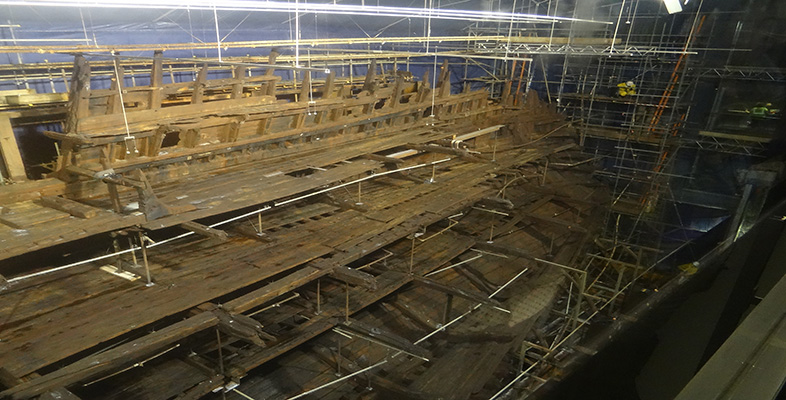4.4 Determining the nationality of the crew
Although organic matter was well preserved in the bones of the sailors, no substantial data on its DNA analyses has been published at the time of writing this course. There has been preliminary work, and the haplogroups identified suggest that the crew may have been of mixed ethnicity, sourced from across Europe. This is surprising, as it was originally considered that the majority of the crew were English.
Stable isotope ratio mass spectrometry can be used to determine the oxygen isotope composition of the crew's remains. Stable isotopes are isotopes that do not undergo radioactive decay and occur at fixed amounts within the Earth. However, variations in the abundances of stable isotopes can occur during reactions and processes that occur in the natural environment. In general, the light isotope of an element will react more readily than the heavier isotope. This process is known as isotopic fractionation.
Oxygen has three stable isotopes, 16O, 17O and 18O. Oxygen is incorporated into the teeth and bones (and shells) of all living organisms. All of the water that humans consume, whether it is drinking water or within food, comes from rivers and oceans with oxygen present within H216O, H217O and H218O. However, climatic factors such as temperature and winds can result in isotopic fractionations; oxygen isotope ratios can therefore be used as geographical tracers.
Abundances of oxygen isotopes are given as ratios, e.g. 17O/16O or 18O/16O and are determined using a stable isotope ratio mass spectrometer. Once these ratios are obtained for a sample, this is mathematically converted into a delta value, e.g. δ18O. Delta values compare the isotope ratio of a sample (e.g. 18O/16O in the case of δ18O) to that of a standard. This value is then multiplied by 1000 to give the delta value in parts per mil (‰).
Stable isotope ratio mass spectrometry was applied to samples of tooth enamel from 18 of the complete skeletons excavated from the Mary Rose. Most had δ18O values of around +24.7‰ to +25.8‰; however, six samples had values of >+27.0‰ (Bell et al., 2009).
As it was originally assumed that the crew of the Mary Rose were English, or at least British, in origin, studies of enamel from 12 British subjects were analysed in conjunction with samples from the Mary Rose. (The study also included horses from Britain, since their tooth enamel exhibits similar regional distinctions.) Modern enamel revealed δ18O values ranging from +23.5‰ to +26.0‰. Other studies have revealed British enamel to have δ18O values as high as +26.8‰.
The majority of enamel from the Mary Rose samples had δ18O values consistent with modern enamel; however, six samples were enriched in 18O. Enriched 18O is associated with hot or lower latitude environments. Therefore, these results suggest that several of the crew may have been from latitudes south of Britain and may not have originated in Britain.
Comparing this modern enamel with the Mary Rose data from bones, was the Mary Rose data consistent with modern enamel, enriched or depleted in 18O?
The majority of enamel from the Mary Rose samples had δ18O values consistent with modern enamel; however, six samples were enriched in 18O.
What might enriched 18O values suggest about the origins of some members of the Mary Rose crew?
Enriched 18O is associated with hot or lower latitude environments. Therefore, these results suggest that several of the crew may have been from latitudes south of Britain and may not have originated in Britain.
Although it is difficult to say for certain that members of the crew were not from Britain, this has been cited as a possible reason for its sinking: poor communication between the crew members because of language barriers may have resulted in misinterpretation or even ignorance of orders. Despite these clues, the true reason for the sinking of the Mary Rose will remain a mystery until more information can be obtained through analysis of the salvaged ship.
